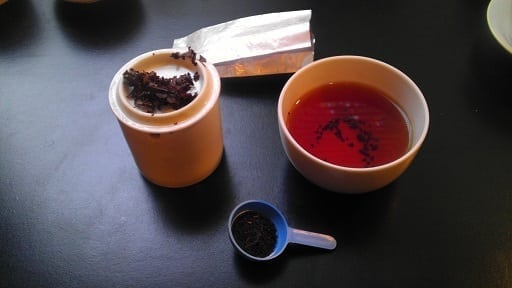I can’t remember when this quest began, but it all started with a random Google search. It was probably in the Fall of 2010, and I ran across an article about Russian tea. What astounded me was that there was mention of Soviet-run tea plantations. That immediately got me digging.
Russia has a long-standing love affair with tea. The country’s rampant consumption of the brew almost rivals Engand, Ireland and Iran combined. I don’t have exact figures; the Russians drank them all. To cater to the demand, government-run plantations were set up in the Dagomys region, near Sochi City, in the Russian krai (federal subject) of Krasnodar. Often considered a tourist spot for the rich, the climate was near-ideal for tea growing – Caucasian sub-tropical.

The tea coming out of the region was dubbed Krasnodarskiy or “Krasnodar Tea”, for short. Or at the very least, that was the first “successful” brand. For the life of me, I couldn’t find the stuff anywhere. I found tea plants from the same cultivar from the region. (Seriously, any tea plant you can buy in the U.S. is probably a Sochi cultivar.) But finding the actual, Russian-grown stuff stateside was next to impossible.
I even hit up Russian delis to find out more. Every one of them gave me the same answer, “Oh, you don’t want that tea. Terrible tea. Russians only drink Ceylon.” Well, that was odd.
It was true, though. Russians did have a particular lean toward Sri Lankan-grown teas. I usually assumed all Ceylons were floral – like those from Nuwara Eliya – but it turns out the lower-altitude stuff was actually rather robust. Perfect for the Russian palate.
Another bit of knowledge that didn’t help my quest was hearing that tea production in Dagomys fell into neglect and disrepair after perestroika. Some independent gardens were getting back on their feet, but none were exporting in large quantities. As such, I considered it a futile quest.
Until Tea Trade Jackie happened upon a video about tea production, and how things were picking back up. The reason: The impending Winter Olympics in Sochi City. Yes, yes…I’m well aware of the controversy surrounding that at the moment – not even gonna begin to touch that subject. I was merely intrigued that interest in Russian-grown tea was back on the rise.
So, I put out my feelers again, pining for any leads on Krasnodarskiy. And I turned up…nothing. Flat nothing. Even after putting it at the top of my Tea WANT! List, there were no beads on the brew. I was back to square one.
Until a couple of years later, when I was in Josh “J-TEA” Chamberlain’s Eugene-based tea shop.
As I was downing mass quantities of his aged Baozhong, he asked me, “Hey, have you had any Russian-grown tea?”
My head snapped up, “No, why?”
“Oh, I have some,” he said as an afterthought. “It’s not very good.”
My jaw dropped. In three years of searching, I hadn’t found Russian-grown tea. In three minutes at a teashop, Russian tea found me. Yakov Smirnoff was probably pointing at me. Laughing inwardly.

Josh kindly gave me some to play around with. A few weeks later, I dug in.

The leaves looked like something in between fannings and broken orange pekoe. They were still noticeably…uh…leaf-like, but they were definitely cut small. There were some tippy pieces in the brown fray, as well as some red-tipped ones. On the nose, it smelled like a dusty black tea – similar to a low-altitude Ceylon…in a teabag. Actually, the aroma reminded me of a Shizuoakan kocha (Japanese black tea), which often had a similar leaf-cut.

I wasn’t sure how exactly I should handle this. So, I went with a typical black tea approach (for me) – 1 tsp. in a 6oz. steeper cup with boiled water for three minutes. I wasn’t expecting hearty nuance, but I didn’t want to scald it, either.
The liquor brewed to a deep copper – like, Assam deep – with a very astringent aroma. It smelled like a burly black tea through-and-through, without much in the way of subtlety. All tannins, no temptation. On taste, the first sensation I got was bitterness, followed by a dry underpinning , and finally a malty character peaked through the top note and finish. This was definitely a burly, barrel-chested Russian breakfast of a tea.

After trying it, I can safely say it’s not the worst black tea I’ve had. Nowhere near the best, but not the worst. It’s very middling in its approached. I think cutting the leaves to just shy of BOP standard probably did the final product an injustice, depriving it of some of its natural Caucasian flavor. (Mountains! Caucasian mountains!) A whole leaf approach would’ve given it a fighting chance against other teas from the region – such as the Georgians I’ve tried. All in all, not bad.
Although, next time…I’m doing it out of a samovar.

Leave a Reply